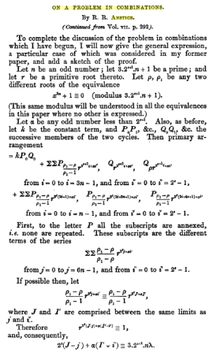Robert Richard Anstice
Robert Richard Anstice (1813–1853) was an English clergyman and mathematician who wrote two remarkable papers on combinatorics,[2] published the same year he died in the Cambridge and Dublin mathematical journal. He pioneered the use of primitive roots in this field, anticipating the work of Eugen Netto on Steiner's triplets.
Robert Richard Anstice | |
|---|---|
 First page of the second part of the article On a problem of combinations (1853) from the Cambridge and Dublin Mathematical Journal. | |
| Born | April 9, 1813 |
| Died | December 17, 1853 (aged 40) |
| Resting place | St. Michael's Church, Madeley, Shropshire[1] 52.633738°N 2.449895°W |
| Alma mater | Christ Church, Oxford |
| Known for | Combinatorics |
| Scientific career | |
| Fields | Mathematics |
| Influenced | Thomas Kirkman |
Anstice studied at Christ Church, Oxford[3] where he graduated in 1835, receiving a Master's in 1837. Nothing is known about his life in the next ten years. In 1846, he was ordained priest, and in the following year he became rector of Wigginton, Hertfordshire.[4] He died there in 1853
References
- Church of St Michael, edited by Historic England
- Crilly, page 488.
- Craik, page 336.
- O'Connor & Robertson, MacTutor History of Mathematics.
Bibliography
- Anderson, Ian; Crilly, Tony (2013). "Robert Richard Anstice (1813–1853): a Hertfordshire bicentenary". Journal of the British Society for the History of Mathematics. 28 (2): 75–83. doi:10.1080/17498430.2013.727146.
- Craik, Alex D.D. (2008). Mr Hopkins' Men: Cambridge Reform and British Mathematics in the 19th Century. Springer. ISBN 978-1-84800-132-9.
- Crilly, Tony (2004). "The Cambridge Mathematical Journal and its descendants: the linchpin of a research community in the early and mid-Victorian Age". Historia Mathematica. 31 (4): 455–497. doi:10.1016/j.hm.2004.03.001. ISSN 0315-0860.
External links
This article is issued from Wikipedia. The text is licensed under Creative Commons - Attribution - Sharealike. Additional terms may apply for the media files.